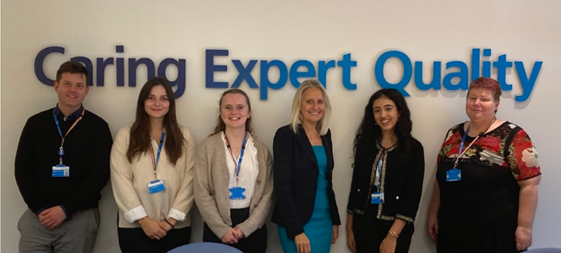GMTS: Trainee experiences at NHS Blood & Transplant
We are working across the business in Commercial, Clinical Services, Plasma for Medicine, Strategy and Transformation, and Organs and Tissues Donation and Transplantation. We have formed a really tight and supportive cohort group, well supported by HR staff at NHSBT. We have diverse roles as a Buyer, Supplier & Contract Manager, Assistant Project Manager and Strategy Analyst.
The orientation has been extensive and we have learned a lot about the unique business and NHS organisation that NHSBT is. The majority of our funding is raised by selling blood products to the NHS as well as some commercial products that help with things like sports injuries. That money funds the innovation and development as well as all the business as usual aspects like transport, estates, corporate functions and the ongoing collection of blood services. Organ donations and transplants are block funded by the Department of Health and Social Care. NHSBT is still offering us site visits to find out how the business works after the traditional orientation.
One of the opportunities we had recently was a discussion with Jo Farrar, the relatively new Chief Executive of NHSBT. No questions were off limits and we had a really interesting and wide-ranging discussion about priorities, leadership, working with government, career options and funding cycles.

Picture of Chief Executive of NHS Blood & Transplant, Jo Farrar, with five GMTS trainees who are on placement in the organisation. From left to right: Gregory Burrows-Delbarry, Bethany Macfarlane, Stephanie Norris , Jo Farrar, Sarina Shah, Sandra Newing-Griffiths.
We all feel we are lucky to be given the opportunities we have had. One of the early experiences, which would be useful to any new graduates as part of orientation, was a tour of the NHSBT site in Filton. We had a PowerPoint introduction to the work of NHSBT and its history and then toured manufacturing (where red blood cells, plasma and platelets are separated and processed after donation) and testing (where machines check all the samples for viruses and bacteria) and the eye bank (where we saw a cornea and a sclera after they had been separated) and we finished with a virtual reality exercise testing blood types. It was an excellent introduction to a unique part of the NHS.
NHSBT would be an interesting place to do a flexi placement to see a very different model of operation. We would all recommend it. If any other trainees would be interested in a NHSBT flexi placement, please contact HR Direct ([email protected] or phone 0117 3227700) in the first instance to express interest.
Written by Sandra Newing-Griffiths, GMTS Trainee